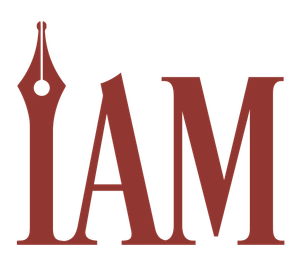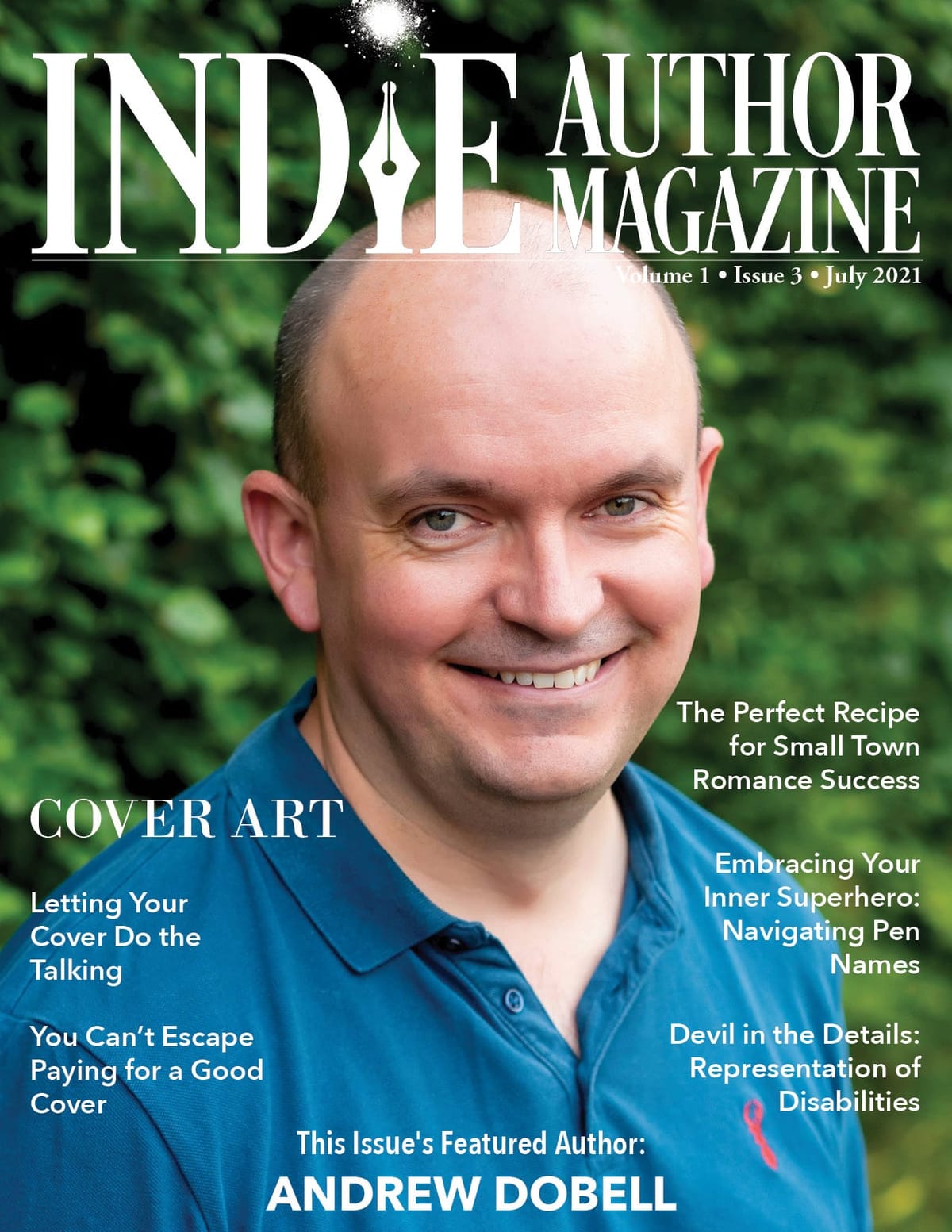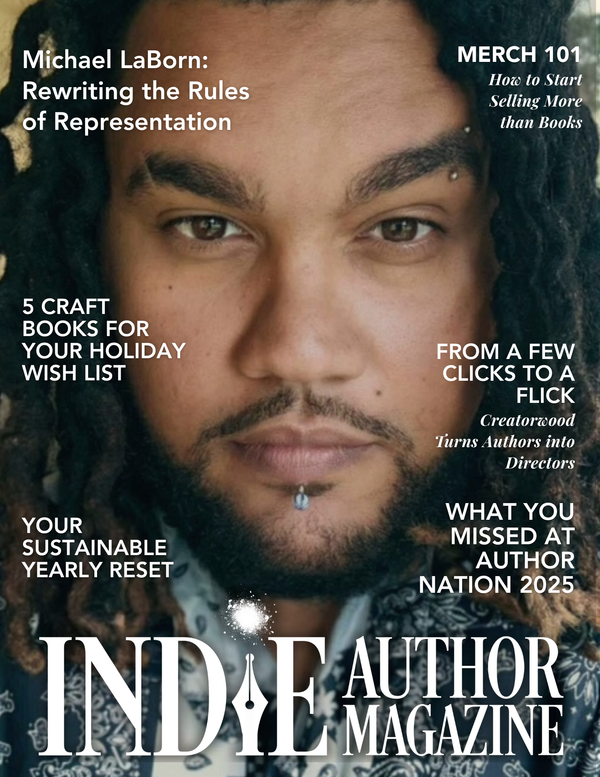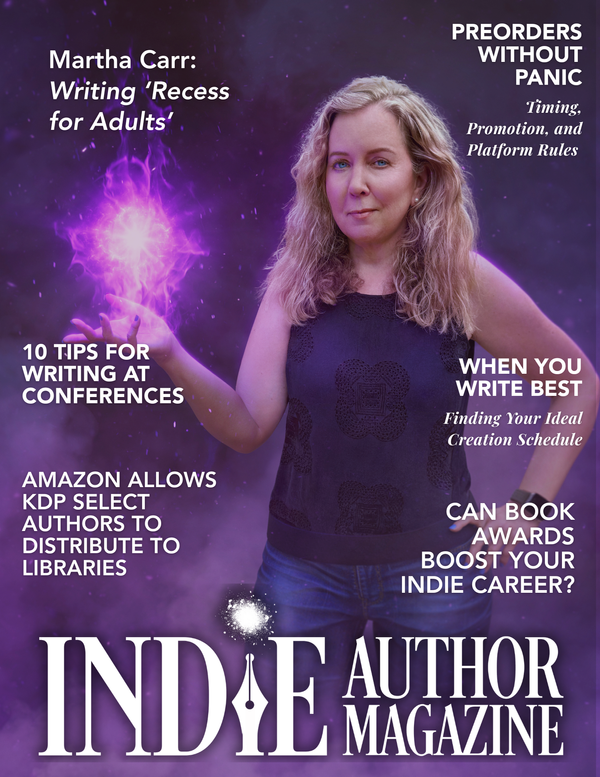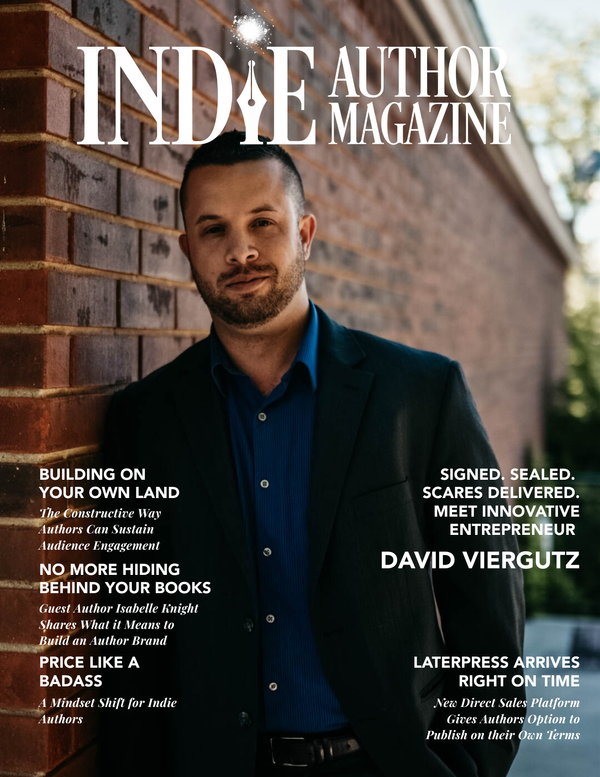Partner Spotlight
|
|
Andrew Dobell: Cover Design & Indie Author Success
Andrew Dobell is a highly regarded British designer whose bright and colorful covers are easily recognizable. He’s also an author who straddles several genres, which makes him the perfect person to ask questions about how his writing influences his cover designs and vice versa.
From the Art
Andrew started out as an illustrator, finding freelance gigs and eventually an in-house job. He’s worked on role playing and computer games, designed tattoos, and still occasionally sees passers-by with his art printed across their T-shirts.
His Photoshop skills date back to 1996 when he used the software in college. Eventually, he moved on to wedding photography and model shoots. Compositing photographs allowed him to place his models in fantastical landscapes, creating new, exciting images. Designing book covers was the next logical step.
It happened around 2016 when Andrew was contacted by Michael Anderle who commissioned him to create the cover for the first book of Michael’s hugely successful Kurtherian Gambit series.
The Write Stuff
When asked about his own writing career, Andrew laughs. “I wrote my first book in 2013, but in 2016 I discovered what self-publishing was. I knew it was a thing but I didn't know people were making a living of it.”
In the same year, Andrew joined the 20booksto50k Facebook group “when it was only a few hundred people.” Networking with other authors also exposed his work to a larger audience and helped him earn more cover commissions. “That’s when I started taking my own books and cover work seriously. It went hand in hand.”
Since then, Andrew has written several series in the genres Urban Fantasy, Cyber Punk, Sci-Fi, and Post-Apocalypse. Recently, after watching the first season of True Detective, he wrote a police procedural under the pen name A.L. Fraine.
His Thrillers play in the same world as his Urban Fantasy, and there might even be some crossing over of characters in future works. Andrew is adamant, however, that his thriller protagonists will not have any magical powers.
Andrew loves moving from genre to genre and not having to comply with anybody’s expectations; it means he never gets bored. Such is the freedom of the indie author, “to be like a magpie and go for the next shiny thing,” as Andrew calls it, tongue-in-cheek.
Finding Balance
Andrew is very strict about the two halves of his creative existence. In the mornings, he writes for several hours until lunchtime. Then he moves on to digital commissions. His clients are mainly in the United States which fits his schedule perfectly. “They don’t usually get up until UK lunchtime,” he quips.
His wife has taken on the marketing side of things. Andrew admits that his strength is the creative work. Analyzing ads is not his thing, whereas his wife enjoys it. Because of the collaboration, the income stream from his writing is increasing. But for the time being, his design business still pays most of the bills.
His greatest challenge when designing his own covers is one that he has in common with every writer. “It’s harder to be objective about my own work. Sometimes it’s easy, and I get an idea and it works. Other times, I have to go through a few covers to find one that works.”
That’s when he steps back and takes a break before he can create a suitable piece of artwork. It gets easier with experience. “The first series is your baby and you throw everything at it. It can be a mess because writers tend to throw all their ideas at the first story. Further on, they become more objective, think of who they’re writing for.”
How to choose a cover (designer)
When asked about what authors need to consider when commissioning cover art, he offers some interesting insights. Most importantly, cover designers need to understand the genre tropes. For example, an Academy novel is likely to have a female central figure dressed in a school uniform in front of a gate with a school building in the background. That doesn’t mean that the story has any of these elements in it. But that’s what the reader looks for when they’re browsing through digital stores.
So when an author approaches Andrew, he engages the client in a two-way conversation, usually through email. What genre is the story? What colors does the author envision? What other covers has the author found that he likes?
There’s often some coaching involved if the author is inexperienced. Andrew helps them understand covers are not literal interpretations of what’s in the book. Instead, the cover needs to convey quickly what genre the story belongs to. It needs to fit in with the competition and look good as a thumbnail.
But above all, a cover’s function is to sell the book.
Know the genre
When asked if cover designers need to read a book before getting to work, Andrew laughs. “No, cover designers don't need to read the book.” He explains all he needs to know is the genre, a description of the main character, if there’s magic, and what kind of weapon the character might hold. If it's Urban Fantasy, the background will probably be a city.
Some authors have very specific ideas. Others are more open to suggestions. It also depends on the genre. Andrew has designed Romance, Western, Urban Fantasy, Sci-Fi, and many more. He monitors design trends in the various genres. Some covers are easier to create than others.
Thriller covers might not have any characters or just have a silhouette against a background. If it’s set in a specific city, he uses the city’s skyline plus some text. Others are far more involved and demand his skills as a designer, using digital painting techniques or 3D creations.
Andrew has some very specific suggestions for beginning authors who may not have the funds to commission bespoke covers. Thriller covers are simple enough that the writer could do them themselves, if they have any rudimentary digital design skills. “It’s not too hard to find a stock photo and put some text on.”
Covers for speculative fiction require a skill set that surpasses most authors’ abilities. There are plenty of designers, however, who offer premades. According to Andrew, they come in a wide price range, some of them very affordable, and still with excellent artwork. “Find something that’s close, and as you put your book out, you can always revisit and change it.”
An eye to the future
Lately, Andrew has been experimenting with 3D software like DAZ and Blender. He says, “3D is fascinating. For a long time, I’ve been wanting to do 3D. I’ve always known that 3D could blast the doors off and give many more options.” In his opinion, DAZ is an easy software to learn compared to other programs. It has led him to creating covers that he couldn’t do before.
When asked about his future plans, Andrew envisions his writing eventually outperforming his design business financially. “I'd never give up doing covers. I enjoy it. It’s a nice break to get away from the writing. They’re both creative outlets, but in different ways.”
Andrew’s work can be found on his author website for speculative fiction https://www.andrewdobellauthor.co.uk. His thriller alter ego can be found on https://alfraineauthor.co.uk, and his cover design business lives on https://www.creativeedgestudios.co.uk.
Best Tools for Indie Authors: Mastering Cover Design
#3 July – Cover Design
If you see a font you want to identify, check out Font Squirrel Matcherator. Just upload an image with type and this tool will show you the fonts that match.
The Brusheezy website has a vast collection of Photoshop documents (PSDs), brushes, patterns, textures, actions, shapes, styles, and gradients to download or share. The brushes can be used in Photoshop or Affinity Photo.
This is an ultimate bundle of Adobe Photoshop add-ons made by Guerillacraft.
With this must-have bundle of layer styles and textures, you will get awesome art prints instantly. For everyone who loves halftones and retro graphics. Easy to use and instant gorgeous effects.
Glamour Absolute is a new “two-faced” bold serif font with both modern and vintage curves. With its split personality, this beauty is very versatile, capable of covering a wide range of projects. A free Photoshop template with the subtle noise texture used in the Creative Market previews is included.
Typewolf is a great resource for tips on pairing type fonts. And one of the most helpful articles was The 40 Best Free Google Fonts.
An Ingram Spark Course: Learn how to design a book cover and interior with book design tips that will help your book reach more readers. This course reveals important publishing industry standards to keep in mind for your book design, whether you create your cover and interior yourself or work with a professional book designer.

Psychology Insights for Indie Writers
Hosted by Dr. Art Markman and Dr. Bob Duke
Each week Dr. Art Markman and Dr. Bob Duke explore different aspects of human behavior and the brain. In conversations hosted by producer Rebecca McInroy, the two renowned psychologists cover everything from the effects of sugar on the brain, to what's happening in our minds while we sleep, and much, much more.
https://podcasts.apple.com/ca/podcast/kut-two-guys-on-your-head/id845287058

Crafting Compelling Small Town Romance Stories
A pinch of this and a dash of that makes for sweetly satisfied readers
Small Town Romance is one of those tried-and-true genres that withstands the test of time. While they seem easy, there are a lot of components that people take for granted.
By the end of this recipe, you’ll be able to tailor the ingredients to write your own story.
Ingredients:
1-3 Settings
2 Intriguing characters
1 Engaging plot
2-3 Tropes
Step One: Season your setting.
The setting is as much a character as the people who live in it. The nature of the small town shapes the people, defines the external conflicts, contributes to the internal conflicts, and adds character to the story.
Pick a town that is removed from the hustle and bustle of big city life. It should have a favorite coffee shop, restaurant, familiar hangout.
Throw in a hefty dose of weather.
If you want forced proximity, make it severe weather.
If you want an idyllic environment, make every day perfect.
Step Two: Add color to your story with interesting characters.
This ingredient comes with a warning. The characters in small-town romance are not caricatures or cartoons.
Characters you can use for your story are:
Real people with real problems,
Specific to the region,
Vibrant,
Open and friendly,
Supportive of each other despite their hidden wounds.
Step Three: Mix your character and settings in a plot.
The plot must have a clear beginning, middle, and end. Here are some must-have plot elements:
The characters within the small town romance have relatable problems.
Whether they like it or not, the characters are involved in each other’s lives.
There is gossip in a small town, but it veers toward being concerned for the people who have stakes in the situation.
If a person in the story uses gossip incorrectly, it backfires.
The town and characters have a common goal. They’ll pull together for an event. It can be a festival, fundraiser, or a friendly competition.
Step Four: Garnish the plot with tropes
Small town romance is known for featuring many of the following tropes. If you include one or more in your story, readers will respond to their favorites.
Second chance. Two characters dabbled with the idea of a relationship, but it fell apart. This is their turn to get it right.
Coming home. One of the romantic leads has returned to the small town. The homecoming is a source of conflict. They don’t want to be there; they’re returning because they tried life elsewhere, and it didn’t work out.
Brother/sister’s best friend. The brother or sister of a best friend has won the heart of a character. For a variety of reasons, this causes friction between the characters who are trying to fall in love and the sibling.
Friends to family. The romantic leads have known each other for a long time. Then one day, they realize the one they were looking for was under their nose the whole time. This can also be used for the fake relationship trope. They’ve been together for so long, no one would blink if they pretended to fall in love.
Opposites attract. They have different tastes. His idea of fun is bowling; hers is hiking the Himalayas. However, the one thing they have in common draws them together.
Cowboy/rancher. He or she is a salt-of-the-earth individual who may or may not be looking for someone to join in their rugged but enriching life.
Girl/Boy next door. This is similar to the friends to family in that the characters know each other. The difference is they weren’t necessarily that close until a combined concern draws them together.
Take the time to enjoy the story while writing it. Laugh with the characters through their high moments and cry with them through the lows. Top it off with a cover that conveys that the story takes place in a setting that people dream about. Indulge with a mug of your favorite hot beverage.
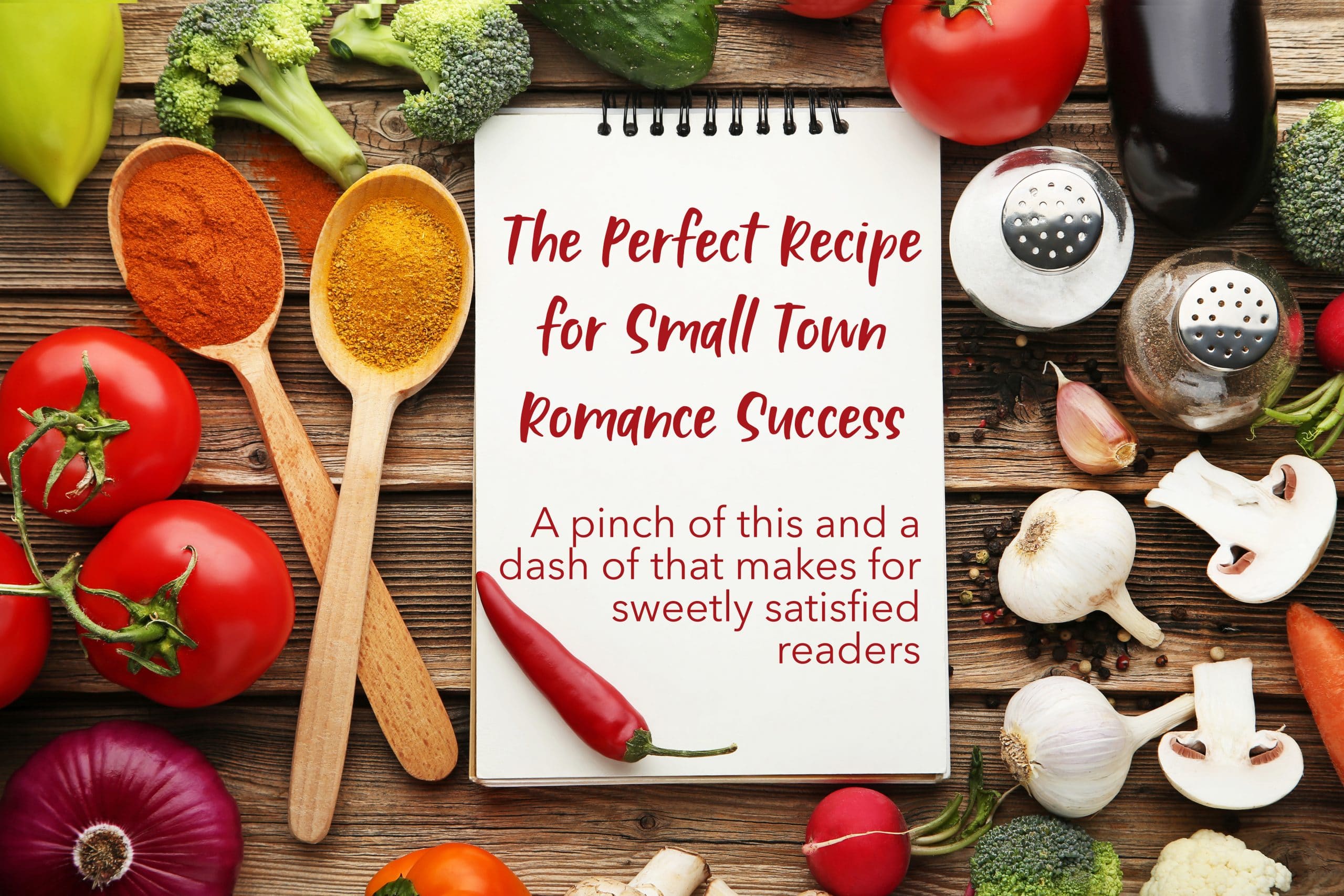
Inclusive Disability Representation in Indie Fiction
When a movie adaptation of Roald Dahl’s The Witches was released in October 2020, viewers weren’t just upset by a change to the story; they were offended.
In the film, the Grand High Witch, whose fingernails resembled cat claws in the book, had hands with only two fingers and a thumb, or split hands, a condition called ectrodactyly. To people with disabilities, the change inadvertently reinforced an all-too-common stereotype—“disability and disfigurement as visual shorthand for evildoing,” writes New York Times reporter Cara Buckley.
But disability representation issues exist in books too. And when disability is incorporated in fiction, it often falls into the same harmful stereotypes depicted in The Witches film.
So how can authors make sure their stories are truly inclusive of the disability community?
Write characters, not caricatures
Fairy tales have long associated disability with villainy, punishment, or something to overcome. Captain Hook, named after his prosthesis, is the villain of Peter Pan. In retellings of Beauty and the Beast, the Beast is often disabled or disfigured. Stories that paint people with disabilities as inspirational simply for living are also problematic, says Madison Parrotta, senior editor at INCLUDAS Publishing. INCLUDAS, founded in 2015, publishes multiple genres, but all its books feature a main character or author with a disability.
These “inspiration” stories often remove any uniqueness or personality from the character outside of their disability, Parrotta, who is disabled, says. Without multidimensional representation for people with disabilities in media, stereotypes create real-world barriers. “That’s harmful for them because when they need help with whatever their disability entails, they might not be able to get it because people view them negatively because of the stereotypes they’ve seen.”
Watch your words
Making sure characters are fully developed—and not infantilized or pitied—is crucial to writing disability narratives well. Sometimes, Parrotta says, word choice can make a big difference. Many people who have disabilities dislike terms like “differently abled” or “wheelchair-bound” for their negative connotations.
Parrotta acknowledges it can be hard to know which terms to avoid if you’re not part of the community you’re writing about. “We’re not perfect,” she says. “I’m sure I’ve written things that are ableist.” But being conscientious of your word choice is an important first step.
Hit the books
When incorporating disability narratives in your work, do your research. Think about your character’s experiences—navigating uneven terrain with a mobility issue—or details to keep in mind, such as avoiding visual descriptions from a character who is blind. Writing realistic fiction? Learn about the legal and societal barriers people with disabilities face. World-building for your fantasy novel? People with disabilities exist there; how does their community accommodate them?
Learn from people with disabilities, and consider hiring a sensitivity reader, Parrotta says. Most importantly, ask yourself whether the story you’re writing is one you can authentically tell.
“The research is so important, but I also think taking a step back is important too,” she says. “If you want to tell a story about a main character who has a disability, and you don’t have that experience, should you really be telling that story? Ask yourself, ‘Why is it so important that you use a disabled character?’”
Writing disabled characters accurately and with nuance takes work and dedication, but it’s critical, Parrotta says. “I feel like if I’d seen more people with disabilities in the books I was reading (as a kid), I would have been a) more apt to find that community and b) accept myself for who I am as a disabled person.”
Research toolbox:
Want to learn more about writing disability inclusively? Check out these resources.
We Need Diverse Books: The nonprofit organization compiles resources for writers and publishers that promote diversity and inclusion in literature.
Vanessa Marie: A self-proclaimed “Booktuber,” her YouTube channel includes multiple videos dedicated to writing diverse characters, including characters with disabilities.
Salt & Sage: Sensitivity expert consultants and readers for hire.
PreviousNext

Pivoting Strategies for Indie Authors
Depending on several factors, the saying “Man Plans, God Laughs” might be familiar to you as a Yiddish Proverb, a quote from author Michael Chabon, or the name of a Public Enemy Album. I’m firmly team third camp.
However you know this witticism, its truth remains. The best laid plans are often waylaid by events beyond our control, and we have to pivot to make the best of the situation.
The last month has been a remarkable example. We crafted a carefully laid plan for expanding our merchant store to Amazon, Etsy, Facebook, and Google. And just as we prepared for takeoff, our server became the target of a massive DDoS attack, our project management software experienced a hack to their corporate database, and a scorpion stung my hand.
You read that right. Scorpion.
Nevertheless, like all successful indie authors, we persisted. We pushed the deadlines, paused the campaigns and went to battle with faceless would-be hackers.
I’m convinced that dogged persistence is part of our collective DNA. I often hear stories from authors that were ready to throw in the towel, but gave something one last try—and then they hit the jackpot. Or they took a chance on another set of editing eyes and discovered they were targeting the wrong genre. Or they made a TikTok that went viral.
So make your plans. The universe might laugh and throw you a curveball or two, but I encourage you to laugh back. Pivot and persist. The next thing might just be the one that brings you the success you’re hoping for.
And, if I can offer one tiny piece of advice, avoid scorpions.
To your success,
Chelle

TikTok Success for Indie Authors: 10 Essential Tips
TikTok is a social media app that allows users to create short videos (fifteen or sixty seconds, with three-minute videos being beta tested). You can also add filters, background music, stickers, and captions to videos, and create split-screen videos with other creators.
What’s in a name?
A username is the @username other TikTok users can use to find you, while a “nickname” is the name visible to users on your profile. Give yourself a username, or TikTok will assign one as “user” followed by a twelve-digit, randomly generated number.
Pro-tip: Keep your name consistent across all of your social media platforms—make it as easy as possible for readers to find you.
In the bio section, you only have eighty words to tell people who you are and what you do, and to ensure you stand out from the crowd. State right up front that you’re an [insert genre here] author. List some interests people might have in common with you and let other like-minded, quirky souls gravitate to you.
Creating content
To create a TikTok, you can record a video with your own camera and load one video, or a series of shorter videos, up to one minute long into the app. You can also film a TikTok directly in the app. Once the video is recorded, you have menu options at the bottom of the screen to add sounds (background music), effects, text, and/or stickers. Along the right-hand side of the screen, there are menu options for filters, adjusting clip length, voice effects, or to add a voiceover to your video.
Pro Tip: At the time of publishing, TikTok is beta testing an option to add captions to your videos. In the meantime, you can download the “Threads” app and use it to film fifteen-second videos with captions, then compile them in the TikTok app and post as one video.
Learn the lingo
When using the app you will find a lot of terminology that might be confusing at first.
Stitch: choose up to five seconds of another TikTok to “stitch” or attach to your own video.
Duet: someone else’s video appears side-by-side on screen with yours.
Transitions: short effects between one scene and another; used to show off a before and after (of a haircut, a recipe you’re making) or switch between two or more characters speaking in a skit you’re recording.
A blind react: record your initial reaction to a TikTok “live,” i.e., without having previewed the video, so you show your genuine/authentic reaction to something unexpected.
How often (and when) should I post?
To work this out for your audience, post four times a day for seven to ten days. Post at the same times every day. At the end of this test period, use TikTok Analytics to assess your followers’ viewing habits and pick the best times of day to post. Posting consistently and frequently—at least two to three times a day—is key to building engagement.
Advance prep
While you cannot schedule posts, TikTok has a “drafts” folder. Take an hour or two and bulk record your videos, tag them with hashtags, and stack them all up in your drafts folder. Then hit “post” at the right times each day. You can intersperse saved videos with other videos you make that come up during the week.
If you see a TikTok with a backing track or humorous voiceover you’d like to use, click it and “save to favorites,” then it’ll be in your favorite sounds when you get time to recreate the TikTok you have your eye on.
Keeping tabs on hot trends
When you open the app, there are five symbols across the bottom. Click the “discover” tab with the magnifying glass icon. Here you will find “trends” and “sounds” that are currently trending on TikTok.
The sounds tag shows the top fifty trending “sounds” people have used as background music to their videos on that day. Use one of the hottest daily sounds for your video, so when people search for videos with that sound, yours will be one they find.
Many creators make original content, but TikTok is also based on the idea of being “uniquely different,” adding your own spin, flair, and creativity to something that’s been done before. Watch TikToks made by other authors who write similar books to you to find what works for your genre.
Tag, you’re it
TikTok allows you space to write a brief description of your video (150 characters). You can tag other creators, and use hashtags to make your TikTok discoverable.
Pro tip: Use at least six hashtags with each of your videos. TikTok will tell you how many views each hashtag has; include some hashtags that have views totaling millions or billions.
Each genre has genre-appropriate hashtags to use for their videos, but a few generic hashtags to get you started include #booktok, #bookish, #authorsoftiktok, #authortok, #writersoftiktok, and #writertok.
Pro-tip: Check trending hashtags each day to see if there are any relevant to your video that you can add to your description.
Embrace the BookTok community
Like Bookstagrammers, Booktokers can be highly influential on the app. Reviews, unboxings, and readings are all tools that can increase your visibility on the app. If a reader does a review of your book, or an unboxing video, duet their video for your own feed. Do you need ARC readers? Make a TikTok asking for volunteers to apply for your ARC team. Booktokers love giveaways, especially for swag and signed paperbacks.
Pro Tip: If you want to stand out, offer a global giveaway. Many authors restrict the winners to the US/UK, so readers are positively disposed when an author extends the reach of the giveaway.
Couch to 1k.
One thousand followers is your first major goal. When you reach this mark (and are over eighteen years old), you can:
go “live” to your followers (connect directly with your followers in real-time and share through a longer form video), and
put a link in your bio (for example a linktree link to your website and all your other socials).
Pro-tip: As you near 1k, make videos talking about it, to drive up your follower count.
If it ain’t fun, what’s the point?
TikTok doesn’t take itself too seriously, so be willing to embrace the ridiculous. If you care too much about what other people think, this may not be the app for you.
Increasing engagement and reach on the app through contributing your take on viral trends means more eyes on your TikToks, and more potential new readers for your books. There is an engaged community of voracious readers on TikTok—winning them over is worth the time investment.
Pro Tip: Talk to your readers, ask what they want to see from you. Before you know it, your readers will send you videos to blind react to, stitch, or duet, and you’ll have all the inspiration you need for relevant, engaging content.
Most of all, have fun—if you are genuinely enjoying yourself that will shine through in your videos.

Self-Publishing Success: Overcoming Overwhelm
Dear Indie Annie,
I’ve finished my first book and sent it off to my editor. While he’s ripping it apart, I’ve started looking into all the things I need to do to self-publish my book—and it’s... a lot. I’m so confused by what I need to do first. And I often find conflicting information. How do I not get overwhelmed by it all?
Thanks,
Floundering in Fairbanks
My Dear Floundering,
Welcome to the world of the Indie Author. In our world, you are the chef, the bottle washer, the maitre d’, and the guy with the sandwich board on the street corner. You’re the chief everything officer.
Things can become overwhelming, and the best advice I can give you is to dig deep inside, grab your inner control freak and bring him or her kicking and screaming to the surface, for this is their time to shine!
You need to be organized. Above all, you need a checklist.
I love lists. I can spend hours, days, if not weeks, creating my list of things to do, embroidering it onto a sampler, and hanging it on the wall to gaze at in admiration whilst I sip my tea and think about my next book. But, here’s a big tip for you in Fairbanks—that doesn’t get the work done.
It gives me a beautiful list. I embroider. Others will create pretty journals, and the really disturbed procrastinators will devise intricate spreadsheets they can flip into graphs and pie charts. But I am not a fan of a pie I can’t eat.
The important part is not the creation of the list, but the putting it into action. Effective action is all about prioritization. An endless list of “things to be done” is an energy suck. Far better to identify the top ten things you have to do and put them in order. “But, how,” I hear you cry, “how, dear Annie, do I know what should be in my top ten?”
I wish there was a simple answer to this, but so much depends on your end goal, your genre, your potential audience, and, above all, your budget. If you can afford to pay for others to do stuff for you, then you can achieve more with your first launch. The same applies if you have a long lead-in time to your launch.
Consider Your Own Circumstances
Take stock of where you are and what you’ll need to get to your destination. Ask and answer questions designed to understand the full scope of what you’ll need. Are you planning to rapid-release? Are you planning to go wide because you have identified that most of your readers are on Kobo? Do you want to release paperbacks or ebooks first? Do you have money for ads? Have you booked in a developmental edit, or are you boot-strapping the entire show and are self-editing with the help of some free software?
First Things First: Focus on the Basics
I’m sure it still feels overwhelming. Focus first on the things you must have. You will need an edited manuscript to upload to Amazon or Draft2Digital, etc. You will need a cover and some marketing materials and so on. There are a lot of tiny important stages to work through for even the softest launch. Focus on producing the very best version of your novel and cover, and then layer on the rest as you’re able to.
Don’t Reinvent the Wheel
The best thing you can do is to read the advice of some really successful indie authors and adapt their checklists to suit your needs. Their books will help you understand the rationale behind their release strategies, and all of them will tell you there’s no one right way.
Break it all down in manageable chunks.
This is your first book, and although I understand you want to get it all right the first time, you won’t. Learn things as you go. Back to my restaurant analogy (ooh, I do love a metaphor). You are an indie author and to make money at this game, you need to learn the business from the bottom up. One day you may be Gordon Ramsey, but even he started by learning how to chop vegetables. Start small, build upon successes, and soon what is hard now will be second nature.
Happy writing,
Indie Annie
X
Indie Annie’s suggested reading:
Craig Martelle’s Release Strategies: Plan your self-publishing schedule for maximum benefit
https://www.amazon.com/dp/B07SJHR39J
Joanna Penn’s Successful Self-Publishing: How to self-publish and market your book
https://www.amazon.com/dp/B019H38JL2
Alice Biggs: Indie Route 101: A Simple Road Map to Publish Your Book
https://www.amazon.com/dp/1948666251
Or if you prefer a course - this one is aimed at total beginners:
David Gaughran’s Starting from Zero
https://courses.davidgaughran.com/courses/starting-from-zero
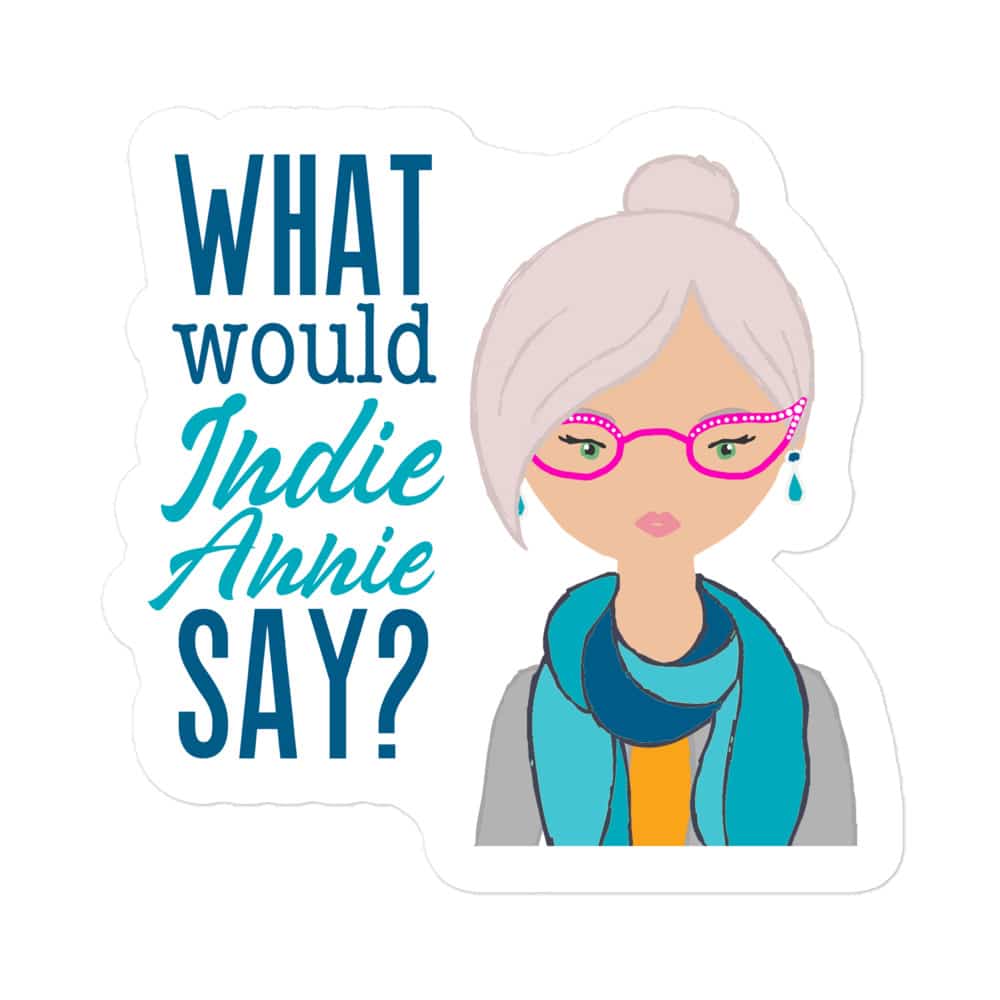
Color Psychology in Book Covers for Indie Authors
How Color Mapping and Psychology Can Help Your Cover Stand Out
In the May issue, we talked about how authors generate trust by having their covers reflect the story within. We pulled several bold and rather red action adventure covers together to compare and contrast the elements to illustrate how the bold designs, font, and red suggested action and resulted in a more effective cover.
This month we’re going to dive deeper into this technique, called a comparable board.
This excellent tool is the refined digital version of the artist’s morgue, a collection of references and inspirations artists collect to brainstorm their concept, visualize the tone and theme.
Authors take this a step further and use them to confirm that their cover is on track.
Combine this with color mapping (identifying the colors present in the image) and color psychology, and you have a powerful tool in this alchemy of words and ideas that we call cover design.
This applies to non-fiction as well as fiction. There will be examples of both as we walk through brainstorming, visualization, and confirmation steps.
How do you gather all your ideas together?
That great notebook you write bits of dialogue in you don’t want to forget or that idea that’s not quite ready to be a story. Or maybe it’s a scrapbook filled with cutouts of magazines, comics, sketches, stickers, ticket stubs, and programs? Or the tech-inclined among you that just opened your Pinterest account and already have a board of each character, location, and weapon (if applicable). Or simply that portion of the wall with all the post-it notes?
If you said yes or smiled as you thought about your own collection method, then you have already completed the first step:
Have a reliable place to collect and the covers that align with the story you’re telling—and check it often.
During the brainstorming and outlining phase, the more images you collect, the better. Explore, but focus on covers in the same genre that generate the same emotions you want to elicit.
The shape of your story and the details you want to reveal to the reader may change from the outline to the final edit. So as your story becomes more concrete, look through your board and remove images that directly serve the story and use them to create a new board. This way you stay on track without losing future inspiration.
What’s the idea that recurs in your novel? The ideal that’s diffused throughout every part of the story?
It’s okay if you don’t know, sometimes you have to feel through it.
But what if you’re creating a non-fiction or a memoir that’s unique and there’s just isn’t anything quite like your book out there?
In that case, focus on how you want your reader to feel when they see the cover and the message you want them to leave with. That is achieved by setting the mood with color.
Bringing the Tone and Theme to Life
Brands spend a lot of money and research finding the perfect colors to engage their audiences. And that makes sense—color is one of the strongest communicators, reaching us on a subconscious level, evoking anything from joy, to frustration, to isolation and triumph.
With the right combination of images and colors, your readers will create strong emotional reactions and associations with your cover, compelling them to buy.
This is referred to as Color Psychology, and while it can be complex, the process can be condensed into a few simple steps.
Choose a color that relates to the emotional pull of your story (consult the images and covers you collected).
For example, red is the color of action, danger, and energy. It boosts the heart rate and promises a story that gets the blood pumping. Darken it a bit and it signifies passion, danger, and opulence.
Yellow motivates the brain and encourages critical thought. Many non-fiction books use yellow, orange, or gold for this reason.
Blues calms the brain and invites the reader to relax and ponder.
There are several great books on color psychology, including Newberry Color Theory by Michael Newberry and The Secret Lives of Color by Kassia St Clair. Canva, the online graphic art program, also has a comprehensive guide that provides the history and meanings of hundreds of colors.
Add no more than two dominant colors that enhance the overall tone without clashing or being too cluttered or noisy.
If that seems a bit daunting, consider a palette creation program like Coolors or Canva’s Color page. Sites like these will create a palette for any image that you upload and even create graphics based on the palette.
Note how the combinations you’ve chosen are used in other books in your genre.
Let’s look at some palette examples using a Sweet Romance, a Paranormal Mystery, and a Business Nonfiction, from left to right.
Notice they all use a primary color that evokes a mood. Underneath the Mistletoe’s blue tones combined with the snowflakes soothes while the cookies evoke thoughts of innocence. There is no spice level here.
Alternately, Carrots has a darker green tone usually used on magical and Urban Fantasy novels. The pop of orange (and the gun) promises action, but is less aggressive than red.
Speaking of red, against the white background—which clears the mind and symbolizes isolation—the large red print of Start is aggressive and compels us to do just that - start, now.
Using these tools from the very beginning helps you and your designer pull together stylish and marketable covers that turn browsers into readers.
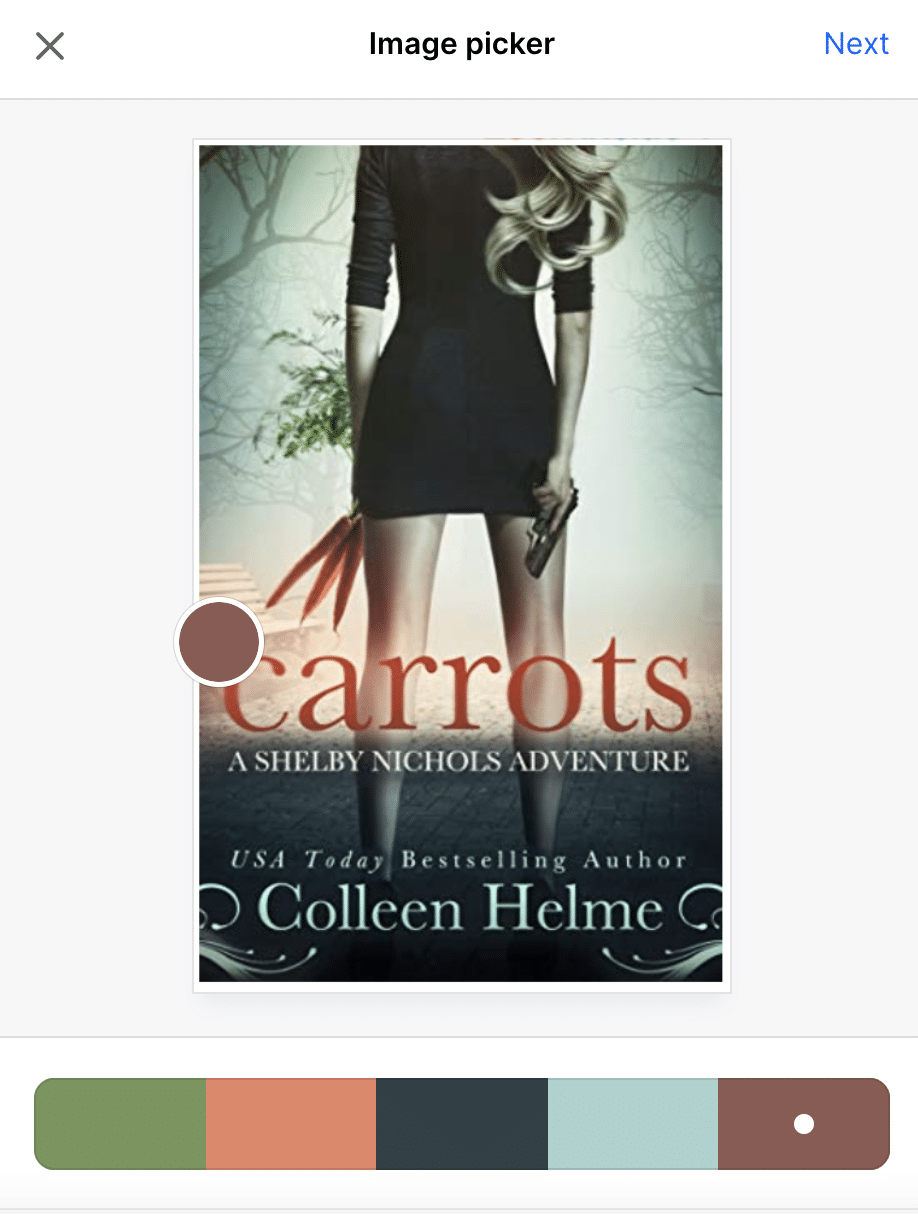
From Writer to Author: Boost Your Book Business Skills
Hosted by K. M. Weiland
Helping Writers Become Authors provides writers help in summoning inspiration, crafting solid characters, outlining and structuring novels, and polishing prose. Learn how to write a book and edit it into a story agents will buy and readers will love.
https://www.helpingwritersbecomeauthors.com/podcasts/
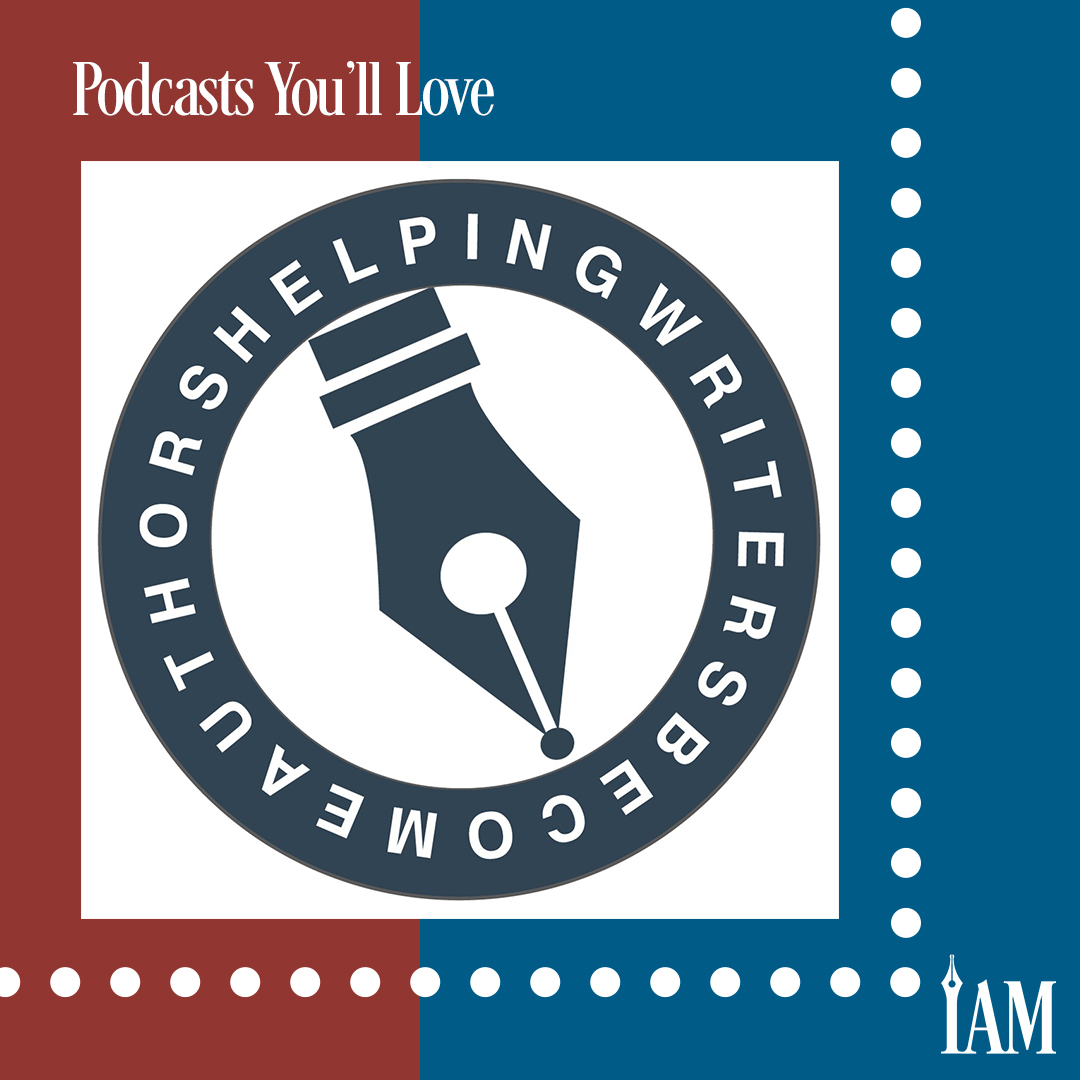
Create Stunning Book Covers with Canva & VistaCreate
It’s no secret that a good cover can sell a book. Once you have a cover made, you want to get that cover in front of as many eyes as possible. This means making advertisements, newsletters, social media posts—even videos—so you can share with your audience and build it. Not everyone is prepared for the learning curve that is Adobe Creative Suite, or Affinity. Fortunately, there are some easier-to-use options with Canva, VistaCreate (formerly Crello), and Bookbrush.
Canva
Canva has been around for a few years now. It’s a design platform geared towards entrepreneurs of all walks. It allows the user to make graphics suitable for all social media platforms, and presentation decks, as well as options for traditional print.
The free version of Canva is a great way to get started. There are hundreds of thousands of free templates, photos, and graphics available to choose from to customize your designs. There is also a feature to invite others to collaborate. Canva provides 5GB of cloud storage for your designs. One of the best free features is the palette generator, though it isn’t easy to find on the site. Scroll down to the footer of the page and it’s listed under resources. This function identifies the colors in any image uploaded, so you can use them in other parts of your design, e.g., text.
Go Pro
Upgrading to Canva Pro unlocks audio and video plus premium content for templates, photos, and graphics. In addition, Pro gives you unlimited use of a new tool, the background remover, which allows you to delete the background of any picture. This is handy when you want to layer the image onto a different background. It also gives you the Magic Resizer, a tool that lets you take any image and make it whatever size needed.
The brand kit is another amazing feature. It allows you to upload fonts, pick and save swatches of colors, and upload logos. Couple this with the palette generator and you’re on your way to solid branding. Having a spot to save content for your author branding alongside your book series branding is not only handy but creates a cohesive look across your designs. A few clicks, drags, and drops, and you can have everything you need ready to go.
Bonus, Canva Pro allows social media post scheduling for up to eight platforms. The content planner function allows you to link your social accounts and schedule unlimited posts. You can immediately set up the image you created to appear on social media when it suits you, and forget about it. This eliminates the need to subscribe to a scheduling service such as HootSuite or PromoRepublic.
VistaCreate (Formerly Crello)
VistaCreate is much like Canva. The free version will allow you five downloads a month but gives you access to over a million premium images, as well as thousands of full HD videos and animations. It also directly pulls from Depositphotos for their catalog of royalty-free stock photos and vectors. You don’t need a Depositphotos account for the free images; it’s covered under Crello. Vectors are a great way to jazz up design because they’re scalable. They don’t get blurry or pixelated when you resize them. The most common vectors for authors are used for cover reveals by layering the vector over the new cover image so that only small bits of the cover are shown as a teaser. Upgrading to the Pro version of Crello adds collaboration, brand kits, and the background remover.
Canva versus VistaCreate
Canva and VistaCreate look and function in a similar way making them easy to work with interchangeably. They both have mobile apps which make designing and posting on the go more convenient. There are some minor differences in the organization of their content. Canva has a blog for tips and updates with their offerings, whereas VistaCreate has an embedded button in their editing panel that will take you to video tutorials of how to use various functions.
Canva Pro is $12.99 USD per month, but $119.99 USD if paid yearly—a saving of 20 percent. VistaCreate Pro is $9.99 USD monthly, but opting to pay yearly will give you a discount, to $7.99 USD per month. VistaCreate Pro doesn’t have all the bells and whistles of Canva Pro but its lower price point reflects that.
A new challenger
Bookbrush is a platform geared entirely towards authors. It eliminates the distraction of the content of Canva and VistaCreate that doesn’t fit the needs of publishing. The benefit of Bookbrush is that, in theory, all of your author design needs—from cover design to advertisements—are met in one place. Its free tier is fifteen downloads in its Custom Creator tool, which downloads to your computer or cloud. You’ll quickly see why upgrading is worth it. The curated author content is a game changer.
There are three levels to upgrade to, and they take a year’s payment up front. Bookbrush Plus is $99 USD per year and grants you access as one author with unlimited penames. You can create ads for all social media platforms with over a million stock photos, author specific stamps—such as review stars, vendor logos for where it’s published, and “like” buttons—3D cover templates that you can apply to your book cover to make it appear that your cover is on an e-reader, eight hundred author specific templates, animation tools, and their Cover Creator tool. You can save fifty projects and backgrounds, and upload fifty images. All of this with premium support.
Moving up to their Gold Tier, which they claim is their most popular, you gain access to Instant Mockups and the Box Set Creator. The Box Set Creator is interesting because it gives you a 3D mock-up of what your set will look like. (Check with your retail store that they accept those images for use; sometimes, box set images are rejected because of how they appear as thumbnails in the online store.) This tier costs $146 USD per year.
Finally, their Platinum Tier gives you unlimited access to their static and 3D content in terms of downloads and uploads. You unlock premium instant mockups and the trailer creator that will create a movie-like teaser for your book. Their background removal tool is also included in this package but is limited to ten uses. This package is $249 USD yearly.
So what do I choose?
Ultimately, each one does a decent job with the basics. As an author, it’s up to you to choose what works best for you and your business. Just starting out? Maybe VistaCreate is better for you with its low price point. Have a series that you’re going to rapid release? Then perhaps Bookbrush’s targeted features are what you want to deploy to launch it with pizazz. Like the idea of scheduling your social media posts? Canva Pro could save you some money from having to subscribe to another service. Whatever your goal is, you can find something in each of these services to help you get there.
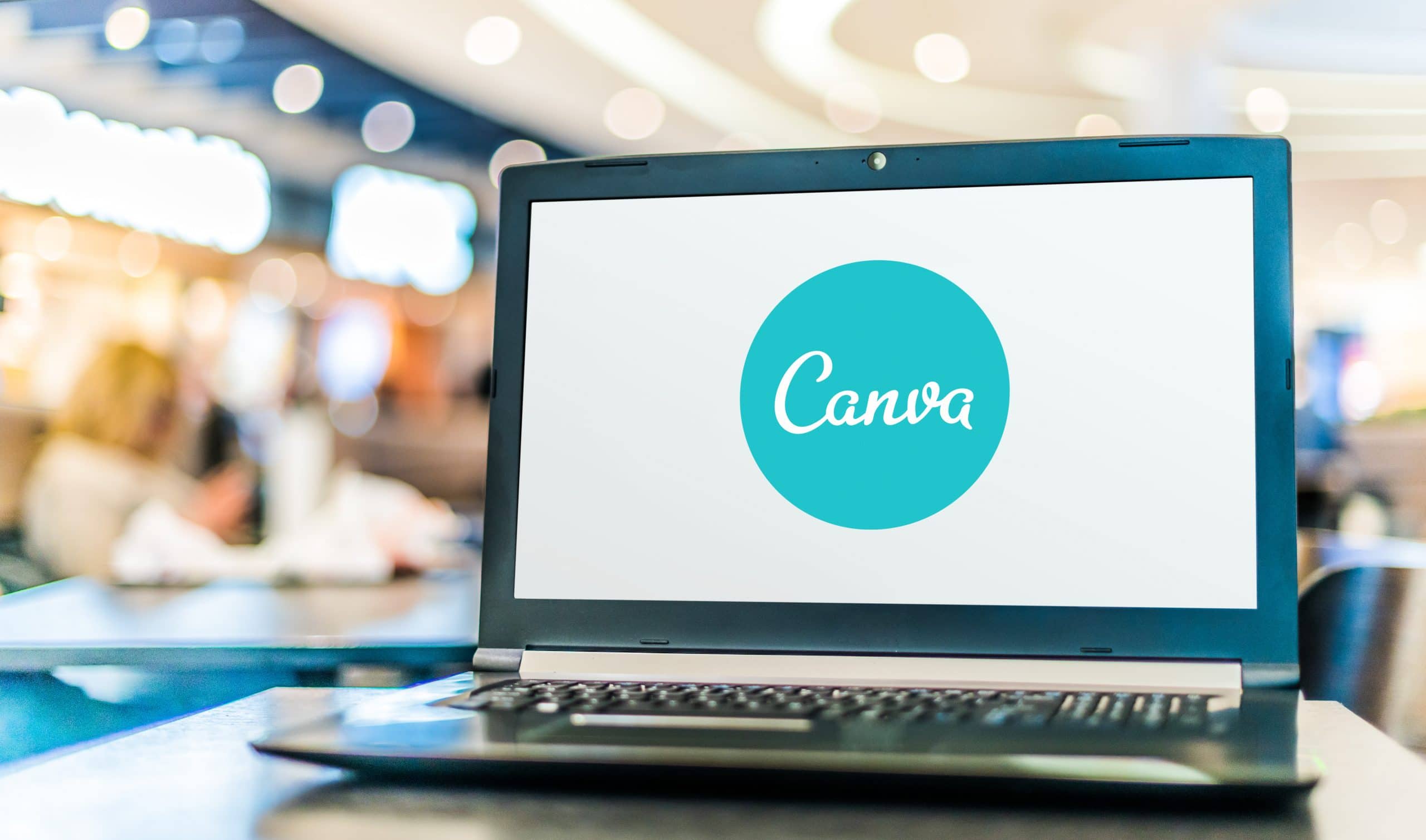
Book Cover Design Tips for Indie Authors
As writers, we want readers to love our book as much as we do, so it behooves us to give it the best possible cover that we can. Whether it’s designing one ourselves, purchasing a premade, or commissioning a custom cover, we want the cover to capture the reader’s attention.
The cover helps us come to a conclusion about the content of that book. As readers, we want to know if the book fits our preferences for genre, tropes, even heat levels, and we trust the cover to tell us some of that information before we ever get to the blurb.
This month, we have articles that will help you with all of those things. We also take a look at what it means to write a serial. And if you’re wanting to write Small Town Romances, we’ve got the perfect recipe to get you started.
Let your cover sing and spark the reader’s imagination of what the story within contains.
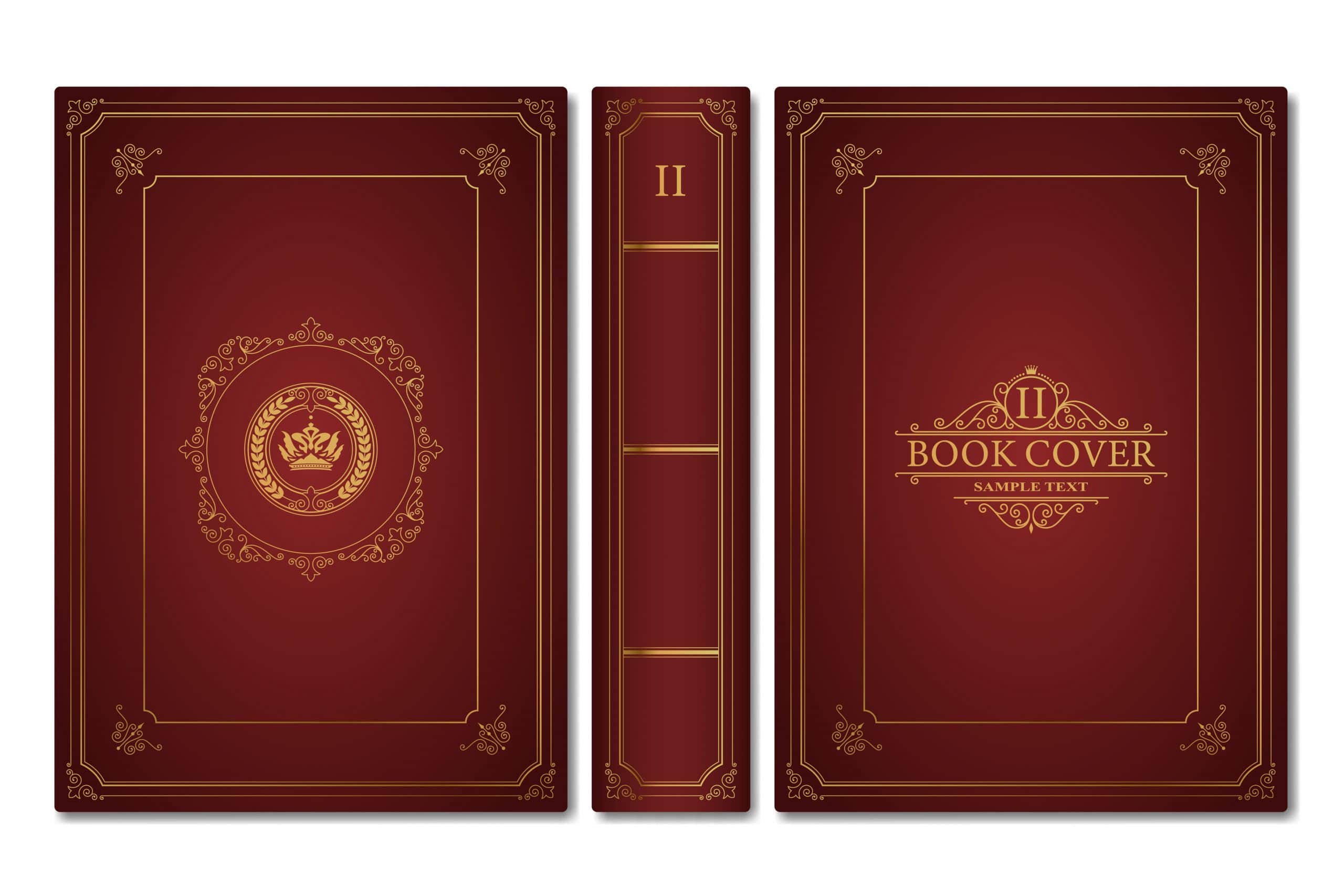
Book Cover Design for Indie Author Success
Book Cover Design Formula
By Anita Nipane
Book 4 of the author’s series focuses on the basics of what readers expect when looking at a book cover, and how authors can measure their cover against those expectations. It’s a straightforward read with lots of specific detail from her perspective as an art director and marketer.
The Author's Guide to Cover Design
By Stuart Bache
Stuart Bache is a well-known designer, with many bestselling designs under his belt. In his guide, he stresses the importance of design briefs when working with cover designers, and breaks down the elements that make designs successful from the marketing perspective.
Cover Your Book: An Author's Guide to Working with a Designer to Maximize your Sales
By Rebekah Haskell
Haskell includes several case studies detailing several genres and gives solid tips for working with designers for both custom design and premades. She also includes advice for audiobook and other non-print versions of design.
The Importance of Book Cover Design and Formatting: For self-published authors
By JD Smith
Author JD Smith offers less of a technical how-to guide, but rather insight into what an author needs to ensure a properly formatted cover with loads of examples and comparisons.
Book Cover Design Secrets You Can Use to Sell More Books
By Derek Murphy
Murphy’s book is a lifehacker’s recipe to getting cover design right. With step-by-step instructions for researching genres and effective checklists for avoiding common mistakes, it offers fantastic insight into how a successful author “cheats” their way to cover success.

Build Your Author Network for Success
Being an author is often considered a lonely existence. But secluding yourself to write feverishly and drink yourself to angst-ridden death is now terribly out of fashion. The authors of today are a new breed. We have Facebook groups and accountability groups, and meet at book fairs, Clubhouse rooms, conferences, and writing retreats. At any time of the day or night, we can log on and find a group of authors writing together on any number of social platforms from Discord to Zoom.
We’re all in this together.
You may have heard this before, but there really never has been a better time to be an author. Whether you’re a new author or have a traditionally published back-catalog as long as your Porsche, the thought of interacting with other writers can be intimidating. How do you ask questions when you don’t even know what you don’t know? Don’t worry, you might have questions that nobody else knows either. Find the answers together.
Cheers from your peers.
The right group of peers can have a positive effect on your career. It’s not as hard as you might imagine finding people who will stay with you while you bash the keyboard to get those last ten thousand words when your deadline is hours away. There’s nothing like the feeling of rallying a friend past the finish line at 3 a.m., then cheering with them as they submit their work to the editor, and, of course, drinking wine together when the manuscript comes back covered in red ink, looking like a frenzied crime scene.
Find your community and be supportive of each other. Whether you’re drawn together because of genre, geographical location, or a mutual love of tie-dyed yoga pants, these are your people, and together you can share knowledge, grow in confidence, and build a stronger community of authors.

Optimize Author Marketing with Prioritization Strategies
Prioritize Your Strategies for a Healthier, Happier Author Life
Ah, the Fear of Missing Out (a.k.a. FOMO). That nagging panic that tricks us into thinking if we don’t try the newest, flashiest marketing strategy populating our news feeds, our author business will wither. It is distracting at best. At worst, it can plunge the unsuspecting author into burnout… And a lot of authors who burn out don’t come back from it. Let’s make sure that doesn’t happen to you.
Yes, I’ve been there, done that, got the T-shirt. I tried to chase the trends, to do it all, looking for that magic bullet (spoiler alert: there is no magic bullet), and I ran my well so dry it’s taken me three years to refill it. The words simply vanished. The stories fell silent. But as I’ve worked on building healthy habits and mindsets, I’ve learned how to question each new shiny that comes into my sphere of awareness.
I use a tool adapted from the Eisenhower Matrix. It’s a simple two-by-two grid, and here’s how I label it:
Top row: High Impact on Sales (This strategy is likely to sell the most books.)
Bottom row: Low Impact on Sales (This strategy is likely to sell only a few books.)
Left column: Low Time Requirement (This strategy will take little time to implement.)
Right column: High Time Requirement (This strategy is going to take a lot of time to implement.)
Now it’s just a matter of looking at the prospective marketing strategy and asking “Will this have a high or low impact on sales? Will it have a high or low impact time requirement?” and seeing which cell it lands in:
1. Sweet Spot (top left): High Impact on Sales/Low Time Requirement. These strategies are going to be your bread and butter—this is where your best ROI will come from. Move these to the “Yes, do this” list.
2. Important (top right): High Impact on Sales/High Time Requirement. These strategies are worth investigating but be conscious of the point when the time requirement outpaces the impact on sales. If the strategy isn’t likely to impact sales enough to make it worth the time requirement, move it to the “Nope (not right now)” column.
3. Unimportant (bottom left): Low Impact on Sales/Low Time Requirement. These strategies are take-it-or-leave-it. If you enjoy it, put it on the “Yes, do this” list. If you don’t enjoy it, move it to the “Nope, (not right now)” list. Making time to do things we enjoy even if they aren’t likely to sell books is important, too, for our mental health.
4. Danger Zone (bottom right): Low Impact on Sales/High Time Requirement. These strategies aren’t going to be worth the time and effort. Move these to the “Nope (not right now)” list.
What if you don’t know how long a strategy will take to implement or whether it will have a high or low impact on sales? Ask. Find your favorite author group and ask those who’ve tried the strategy. Look for the keywords in their responses.
One more word of advice: the market changes. Fast. And so does the efficacy of marketing strategies, so it’s always a good idea to periodically “check in” with strategies, even if you’ve moved them to the “Nope (not right now)” list.
Sweet. Simple. Effective. This tool has saved me a lot of headaches and lost time and energy that I’ve been able to put toward better things—like burnout recovery and writing my next book.
PreviousNext
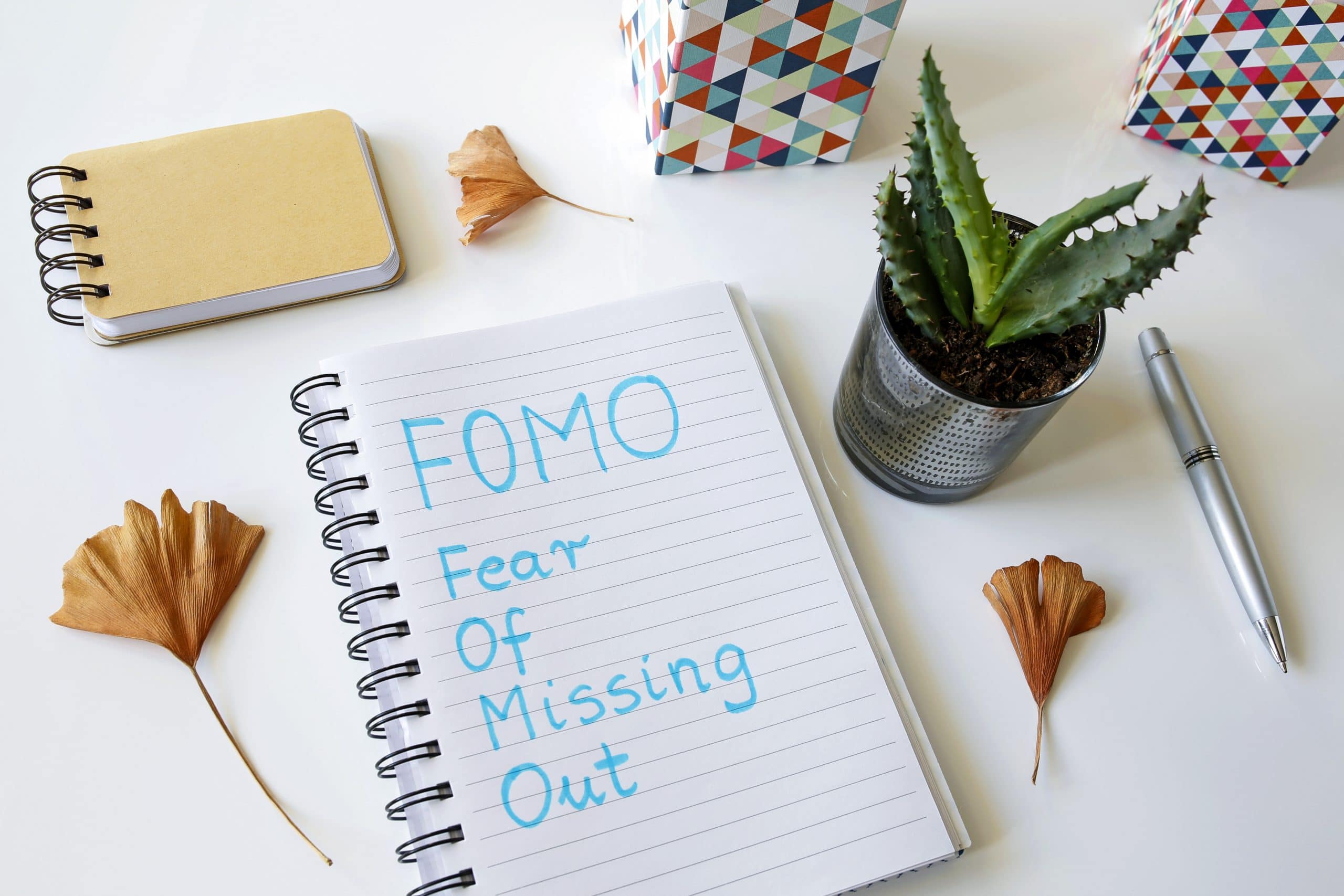
First Impressions in Book Cover Design
“Judge a book by its cover.”
We're told not to, but we all do it.
First impressions count, and this is your chance. What will your cover tell the world about your story?
In this issue, we explore some of the design elements that make a cover stand out for the right reasons. A good cover will cost you—either money or time. If you decide to do it yourself, we look at some tools to help you, so you can determine which one best suits your needs.
You might think TikTok is just for teenagers to share bad dancing attempts, but it is emerging as a strong platform for selling books. We take you through how to set up your account and grow your author brand.
At Indie Author Magazine, we believe that inclusion is fundamentally important. But in fiction, how do we avoid harmful stereotypes when trying to be inclusive of situations beyond our own experience? This month's Devil in the Details looks at representation of disability in fiction.
You only get one chance to make a first impression—let’s make it a great one!

Character Development: Embrace Unexpected Strengths
As the designer on the team, I’m excited to provide you with several ways to up your cover game in this issue of Indie Author Magazine.
But, in another life, I am an Occupational Therapist, and have worked with people with disabilities throughout my career. So I’m especially glad for our Devil in the Details feature this month: Disability in Fiction. In graduate school, they taught us all about “typical” disabilities and their presentation—but they also emphasized that out in the “real world,” very few people would be the classic, textbook case.
Everyone is different.
Everyone is unique.
Not just in the manifestation of a disease process or congenital issue, but in the way that the disability added to an entire milieu for the person. Other comorbidities, family support and health, and many other factors would determine how the person coped or possibly thrived with whatever made them different.
People are multidimensional, and often the thing that makes them the most fascinating isn’t what’s most obvious.
As a new grad, I learned this with two patients who arrived to the floor where I worked with very similar physical diagnoses. One was a man in his 40s, the other a woman in her 80s. You would think the young man would have made more progress and adapted much better than the elderly woman.
The opposite was the case.
I never knew all the reasons why, and it wasn’t my role to sort that out. But from what I knew, it was the other stuff in their lives that made the difference. The condition led to a permanent disability for the man, but not the woman. She persevered and overcame; he gave up and surrendered. She was still looking forward. He was looking back.
What will make the difference for your characters?
Where will they find the courage to thrive?
How will they inspire the rest of us?

Affordable Book Cover Strategies for Indie Authors
The Only Question is How: Sweat Equity or Actual Money?
The book cover is the first impression potential readers will have of your work and is what stops them scrolling as they search for something new to read. Beside considerations of genre, title, niche, and tone, your most important question is, how do you source a cover for your book? Reader expectation is everything and the cover should convey the contents well, but that needn’t come with a high price tag.
In her article “Cover Design Brief,” Anne Ericsson says it well, “There’s a classic project management saying that goes, ‘We have three kinds of services: fast, good and cheap. Pick two.’ When arranging the book cover design brief, consider which goals you’d like to prioritize, because one cannot work under all three constraints.” (https://blog.reedsy.com/cover-design-brief)
So, you have a choice: you can create your own, search and purchase a premade from a cover designer, or commission a custom. Each will save time or money to varying degrees.
Options for different budgets
Creating your own cover can be the cheapest financially but will cost you in sweat equity. It can take time, some knowledge, and acquired skill, but is an option if you are strapped for cash or wanting to bootstrap your author business. Practice is needed to make your cover look as good as a custom from a designer. Design skills take time to learn and not everyone has the ability. Knowledge of the market is important. Getting that wrong could be the difference between the book selling or not selling. David Gaughran echoes this in his comprehensive article “How To Design A Book Cover That Sells,” “Without the right cover, no one will give your book a chance, no matter how well-written it is, or how diligent your editor.” (https://davidgaughran.com/book-cover-design).
DIY Covers
You can design your own covers with stock images, using programs such as Canva, Book Brush, and Crello, which are free to sign up to. Our technology article, (insert title and link), goes into more detail.
The more advanced program Affinity Photo comes with a price tag just under $50, with deals often found cutting that in half. Compare that with the industry gold-standard Adobe Photoshop which when bundled into the Creative Cloud with other design programs runs about $80 per month or $34 per month on its own. These have steeper learning curves, but a wealth of tutorials, hacks, and resources are easily found.
Stock Images
Stock images are ready-made photos sourced from stock photo agencies to legally use for creating your cover. The agencies have subscription or credit-based models for the two common types of licenses for image use: royalty-free and rights-managed. It is necessary for you to understand image copyright, stock photo licensing terms, and usage rules to avoid infringement issues.
A royalty-free license grants you repeated basic use of the purchased image as permitted by the licensing agreement. The cheap cost means it is non-transferable and non-exclusive, meaning you can’t give it to anyone else and you could see that image on any number of covers.. It has no geographical or time limitation, and you can use the images for print, digital, and other editorial methods of use. These differ from editorial and commercial royalty-free licenses.
Royalty-free images are an affordable option, and you can buy them at reduced rates or benefit from free trials from stock photo agencies such as https://www.shutterstock.com and https://stock.adobe.com. Many authors use https://www.depositphotos.com to purchase their stock images.
In contrast, the price of a rights-managed image license is calculated based on how often you would use the image, the medium and duration of use, how many potential viewers you’ll have, and the display size, placement and geographical area. This exclusive license can be expensive, has many restrictions, and expires. Only one person can purchase the image so you will have the sole rights to use it which can prevent those embarrassing side-by-side shots of your model on another author’s cover.
Sweat Equity
But the monetary cost of these programs and stock is only part of the expenditure for designing your own cover. Ten thousand hours is considered the time to master a skill; that’s forty-hour weeks, fifty weeks of the year, for five years. Some people may have already racked up these hours through other endeavors, and thus are better positioned to create their own covers, but at some point, you’re going to have to accept that your covers may not be as good as a professionally designed one.
Leverage templates and tools to cut down on the time you’ll spend learning new skills. Aim for a cover that fits the genre trends and decide that a cover that is “good enough” will still sell books.
Premade Covers
Premade covers are created by the cover designer ahead of time and remove many of the frustrations from a mismatch between your ideas and the designer’s output. You can see exactly what you are buying and have the cover for use in rapid time. Premades are a great alternative to making your own for a reasonable price and are as professional as a custom purchase. They are available as standalones or in series and can be found on cover designers’ websites, cover depositories such as https://thebookcoverdesigner.com and https://coverdesignerdirectory.com, and Facebook groups such as Book Cover Gallery and Book Cover Design Marketplace.
You will have a trade-off between time spent searching for your ideal cover, where all is needed is to add a title and your author name, and paying for a custom. A great premade can be found for half the price of a custom cover or less as some designers knock down their covers to sales prices to sell older unsold stock. Others spend months creating designs for a massive sale on a certain date. In either case, each cover will only be sold once, but due diligence is needed to confirm this.
Buying a premade can be a great opportunity to obtain a cover from a designer you admire at a lower price. Otherwise, it is worth considering the reputation of the designer or getting recommendations from other authors who have used their work.
Custom Covers
Working with a cover designer will often take you less time than creating your own or searching for a premade, but is likely to come at a higher cost. The price can range anywhere from a few hundred dollars to a couple of thousand, and designers with a proven track record may cost even more.
Many people choose to work with a cover designer as they want to make an unforgettable first impression; readers do judge a book by its cover, and you have on average 8-15 seconds to make that impression. This includes the cover representing your genre reader expectations and therefore targeting the right audience while avoiding clichés and keeping up with industry trends. Understanding the market is vital to stop readers scrolling past your book at thumbnail size and why “a professional designer reflects his knowledge of the market when creating your cover art”
It could make things easier for you if your designer can take direction and listen to your vision while also pointing out where things could be better or even corrected to align with the book you want to sell. Paying a higher price may not guarantee a bestselling cover, but you will probably get great concepts from the designer and a quality product. Remember that part of what you are paying for is the designer’s skill and experience in design and understanding the market.
While you pay separately for ebook and paperback covers, these may be offered at a discount price when bought together. Some designers also provide free packages of social media graphics for marketing purposes on your website and social media platforms.
It is up to you to decide where your skill level lies and how competent you can be. The deciding factor will always come down to the time and the finances you have available for cover creation, because after all time equals money too.

Serial Fiction Success for Indie Authors
If you’ve perused author-centric Facebook groups and some articles here at Indie Author Magazine over the last sixty days, you’ve likely seen chatter about the unveiling of Amazon’s new serialized fiction platform, Kindle Vella.
But serial fiction isn’t new. Writers have been peddling their wares on platforms like Wattpad, Radish Fiction, and Royal Road for years.
And while the speculation continues regarding some of Vella’s finer details, there is one question consistently making the rounds: How do you craft successful serial fiction?
Novelization vs. Serialization
In order to understand what makes a serial successful, we first have to define the difference in novels and serials.
You might have also heard of one specific strategy to repurpose standard novels in order to jump into this new Kindle marketplace. However, in speaking with Alana Albertson, romance author of the Se7en Deadly SEALS Series, previously number two on Radish Fiction, the one thing that became very clear was that serials are not chopped up novels.
But how do you differentiate? For novels, chapters are intended to move the plot and develop the characters, but depending on the genre, it’s not unheard of to slow the pace and use world-building, witty dialogue, and expertly woven backstory. Serials employ some of the same tricks, but more succinctly and with the goal of keeping the reader on the hook at every turn. Where a novel chapter might end with a scene’s uneventful natural break, a serial episode ends with a bang. The addictive nature of serialized fiction should make you need to download that next episode.
For Alana, that hook, that bang, is either a full-blown cliffhanger meltdown, or what she calls a “mini cliff.”
The Art of the Cliffhanger
Most people will identify a cliffhanger as a writing device that ends the scene on a rising action such as a surprise revelation, death, or crime. In Alana’s writing, cliffhangers are both that level of drama or “so cliff” as she says, and more subtle, such as a discovery or clue. Those mini cliffs keep your reader on the trail of breadcrumbs until they reach the bang.
It is, however, not enough to drop a bomb into the story; you must also provide a resolution. If you think of serial fiction like your favorite TV crime drama, it’s easy to understand how you’d never end the episode without solving the crime. Writing for the serial audience is the same; delivering on reader expectations includes answering the questions after the cliffhanger as promised and providing closure.
Getting Started with Serial Structure
While plotting may or may not be your favorite practice as an author, there seems to be a solid argument why some form of outline or plot gardening would be necessary for the serial format. Working with multiple storylines stretched over the course of a multi-episode season or over interconnected series takes a game plan.
Alana Albertson echoes that sentiment. “I am a recovered pantser. It took years. You don’t want to plot your shirt off, but before I wrote the first word, I knew exactly what was going to happen at the end of the series, from day one. I plot by cliffs.”
When considering how to outline your serial, give yourself options, both with the plotting method, which you can read more about in our May 2021 issue, and with the story itself. If serialization is an experiment for you, having a few episodes with a natural resolution but with expandable borders, might be the key. Tossing in some of those mentioned breadcrumbs regarding side characters, quests, or connected worlds can assist with sustainability in the future.
Based on the concept of plotting for longevity, let’s review what that might actually look like. Going back to the crime drama example above, a good visual representation might be one of the most-watched shows in the US, Law & Order. The original series aired for twenty seasons with an average of twenty-two episodes per season. The original series also spawned six additional television series under the same franchise.
When we think of the structure of something that massive, it is easy to feel overwhelmed, but let’s break that down to a more manageable place. In Law & Order, each episode has a crime that must be solved before we reach the final minutes. Each season has a larger issue, sometimes called the “prevailing plot,” such as a serial killer or court case, moving toward a separate resolution. Each spinoff has the same world, but with its very own set of crimes, characters, and grand season arcs. For serials, the format is similar, except your episode consists of far fewer words than the forty-five minutes granted to a television program. Essentially, you’re packing all that drama into bite-sized pieces that each end with a reason for the reader to keep going.
According to A.C. Fuller, author of The Crime Beat, a nine episode novella series available on all major retailers, “My hunch is that readers are not going to want seven-hundred-word episodes that don’t actually resolve anything, that don’t have their own individual arcs, that are just kind of chunks of a larger chapter that’s hacked off ... I think readers will prefer to pay for longer episodes in Kindle Vella that are three thousand to five thousand words, that have enough of an arc to them that a discrete storyline or discrete scene is resolved.”
We’ve talked about planning for longevity, adding compelling action, and structuring to meet the quick pace, but what about the beginning? As with any story, you only have a few hundred words to grab and keep the reader’s attention. In novels, prologues can work, but with serials, the desire to invest must be immediate.
Bottom line: Serials should have that same binge-worthy, addictive quality that keeps 200+ million of us subscribed to Netflix each year.
Serialized Fiction Craft Resources
While it’s important to note that there are many ways to craft and fine-tune a serial, we are not limited to deciding on the right approach solely based on the speculation surrounding Kindle Vella. Authors like Alana, A.C., and many others have already shared various data sets that we can use as research.
Great examples of serialized fiction to read and learn from exist on many sites, including:
Radish Fiction: https://www.radishfiction.com
Wattpad: https://www.wattpad.com
Royal Road: https://www.royalroad.com/fiction/708/fiction
Tapas: https://tapas.io/
There are also several Facebook and Clubhouse groups devoted to the Vella discussion where you can find authors of all mindsets, genres, and experience levels freely sharing the bulk of their combined knowledge. One example for Facebook is Kindle Vella Authors. On Clubhouse, you can listen and join the Vella Club.
Additional resources and classes:
Six Figure Serials course by Alana Albertson, https://alana-albertson.mykajabi.com/offers/gkGuQGZV/checkout
www.rebelwriters.com by HM Ward
How to Write Light Novels and Webnovels, https://www.amazon.com/dp/B07WRMJ663/
Author Brittany Wang on YouTube, Plot a Story: Story Structure for Serials + Free Templates, https://www.youtube.com/watch?v=s463z7gOFvg
On Episodic Storytelling by Keely Hill,
https://keelyhill.com/other/episodic-storytelling/
Plottr on YouTube, How to Outline Serialized Fiction with CM Adler (Free Episodic Plot Template), https://www.youtube.com/watch?v=4i_cJST18Js
Unlimited Story on YouTube, How to Write Serial/Episodic Fiction, https://www.youtube.com/watch?v=sntSw6FJa3Q
Ines Johnson on YouTube, Serialized: How to Use Episodic TV Structure in Your Novel
https://www.youtube.com/watch?v=2rVun6FoQAU
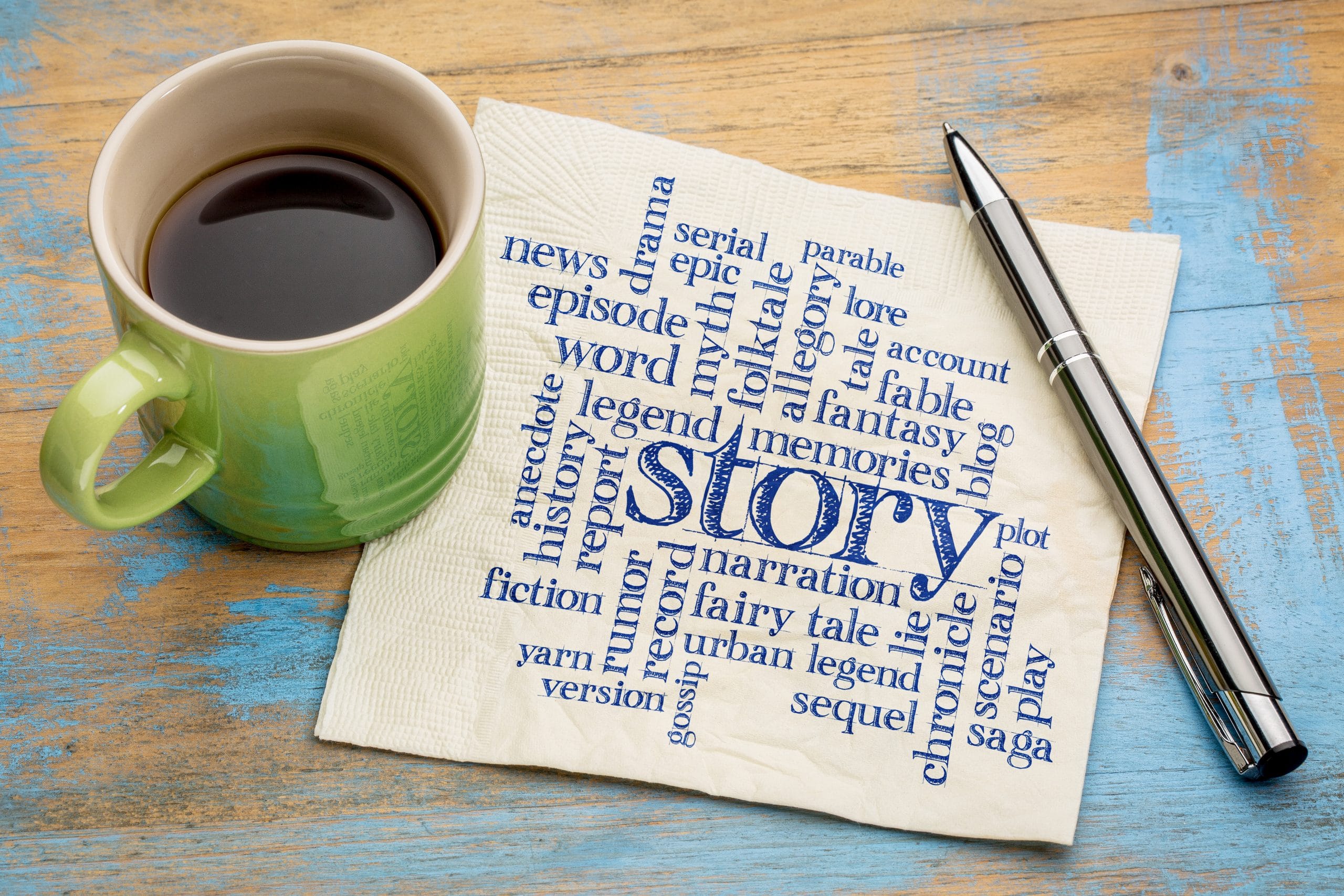
Indie Authors: Mastering Pen Names for Writing Success
Is It Time to Embrace Your Inner Superhero?
Secret identities aren’t reserved for superheroes. There are no masks, no capes, no utility belts; and despite the lack of a fabulous wardrobe, an author may still require an alter-ego for success. These noms de plume, commonly known as pen names, can, if used correctly, be an asset to an author’s career. Inventing an identity comes with benefits and difficulties an author may not be considering as they conjure their new persona. At the start of your journey you only need to answer one question, “Why?”
Why the secrecy?
Privacy
The reasoning might be as simple as, “I don’t want my family/job to know that I write or what I write.” You might not want to make Nanna blush as she discovers your penchant for steamy regency romance. There might also be a career conflict where an employer would be less than thrilled to discover you wrote bone-chilling horror. Urban Fantasy Romance author Dora Blume, whose real name is Danielle Staley, encountered a less than open mind from her day job supervisor. Blume, a former middle school English teacher, recalls, “When I used my [legal] name for my Fat Girl Problems blog, I had parent complaints. I was asked by a principal to take down the blog.”
Brand Division
There are also logistical reasons behind wanting to develop a new persona. While some genres such as fantasy and urban fantasy might intermingle on the bookshelf, the way they are discovered through online retailers is not as straightforward. Jenn Falls, writing as Bella Falls, has found success in the cozy mystery genre. However, she maintains separate pen names for her romance and paranormal series. Standing firmly behind the idea of not polluting any of her brands, she is preparing to launch a new name. “Even though I have readers that would read [pen name] ... when I launch, I will keep it in a vacuum so I can see how it does on its own. After hyper targeted ads, I might let it be known.”
Gender
Reader expectations can also impact the decision. Joanna Penn writes in the male-dominated thriller genre under the pseudonym J.F. Penn, despite a successful career publishing non-fiction. We can find the opposite as males tackle female dominated genres such as cozy mystery or romance. Tyler Davis and his wife wrote paranormal cozy mysteries under the pen name Christine Zane Thomas. Tyler has since fully assumed the identity of their erstwhile joint pen name. It makes sense to continue publishing under a name he helped make successful, but it comes as a double-edged sword. He says, “I feel disingenuous when people message my page and talk to me.”
Name Conflicts
Because an author relies on discoverability regardless of platform, sometimes the why is as simple as ease. Having a common name such as “Smith,” means that it can quickly push an author down the search results. It can also be a case of having a name that is difficult to pronounce or even spell. Timothy Cerepaka, who writes under Lucas Flint states, “it is easier to spell/remember than my real name while remaining distinct.” However, he is quick to offer a word of caution, “I like [the name] Lucas Flint, so I don’t mind it when people call me that, even though it’s not my real name … pick a good name and prepare to get used to it.”
Behind the Mask
No matter an author’s reasoning, they must know not all pen names are created equal. The need for a pen name has been established, then what? Authors use different approaches to their pen names depending on their unique situations. Ultimately, it boils down to privacy, and how secret the name will need to be to achieve an author’s goals. It can roughly break down into three categories: public, semi-private, and anonymous.
Public Identity
This is the maskless superhero approach. It allows the world to know that an author is assuming multiple identities, and is mostly born out of administrative logistics. Barry Hutchison traditionally published children’s books under his legal name, but published his first science fiction under Barry J. Hutchison to denote books written for “adults.” “I didn’t want kids looking for the next Barry Hutchison book … to [find] a book where a person is tortured to death or set on fire.”
Benefits: Brand Division | Minimal Duplication of Social Media Efforts | Maintain reader trust
Concerns: Algorithm Cross Contamination
Semi-Private
Readers might not quite know who is saving the day, but the identity is thinly veiled and discovery isn’t a major concern. This can be an author openly admitting to a side project or giving a novel time to stand on its own legs before introducing an existing audience. While Hutchison only used an additional initial to signal age-appropriateness, when he moved to writing crime thrillers as J.D. Kirk, it required a temporary secrecy to prevent confusing the search engines. “It was Amazon’s algorithm that I was thinking about, because I knew I had several thousand Space Team fans, that if I put out a new book under that name all those Space Team readers would jump on it, regardless of what that book was about.”
Benefits: Brand division | Maintain reader trust
Concerns: Algorithm cross contamination | Duplication of Social Media Efforts
Anonymous
Innocent civilians can’t know that a pen name is a secret identity, and discovery could place an author in peril. This can originate from the need to create a separate business entity to protect assets or to prevent disastrous ramifications with other careers. It can also result from co-authors wanting to combine their efforts behind a single identity. Authors in this situation become their pen name, and there is no discernable way to identify that they may have a different legal name. While Tyler Davis has assumed a level of anonymity as Christine Zane Thomas, he has considered transitioning to a semi-private penname. “I consider it all the time. But it’s mainly a problem of doing it consistently, otherwise a new person will think, ‘Who ... is Tyler Davis?’”
Benefits: Brand division | No algorithm cross contamination | Asset protection
Concerns: Duplication of social media efforts | If not incorporated, exposure by utilizing legal name with vendors | Exposure by Technology (e.g. Facebook or Instagram)
Authors: Assemble!
Before deciding to assume a new identity, there are several questions an author can ask to help decide if a pen name is necessary:
Do I need to separate my non-author life from my writing career?
Does my genre favor a particular gender?
Will I be writing in a different genre (that has little or no overlap with an existing audience)?
Is my legal name common in my genre, or is it difficult to discover because of its uniqueness?
Am I prepared to assume an alter-ego as if they were a real person?
Just as there is a spectrum between superheroes and supervillains, so is there a wide assortment of reasons and logistics behind a pen name. This list is an entry point, but by no means exhaustive. Each author must weigh the benefits and consequences along with the labor involved, and there is no one-size-fits-all approach.

💡
The Rest of This Issue is for Paid Subscribers Only
Get more than just tips—get real results. As a paid subscriber, you'll unlock the full-color issue, VIP access to webinars and training, discounts on software and tools, and a community to support your journey.
Get more than just tips—get real results. As a paid subscriber, you'll unlock the full-color issue, VIP access to webinars and training, discounts on software and tools, and a community to support your journey.

